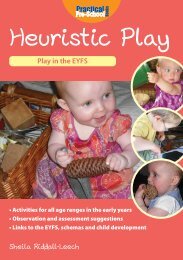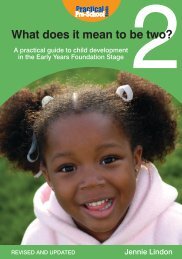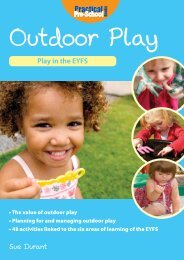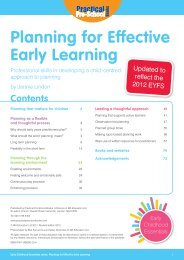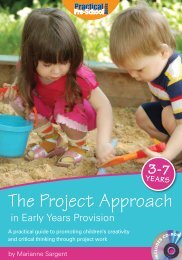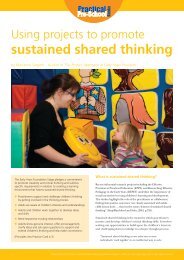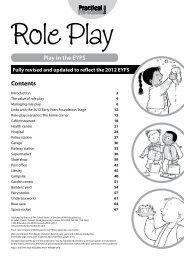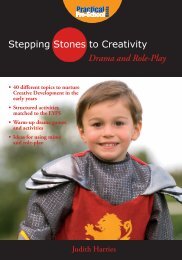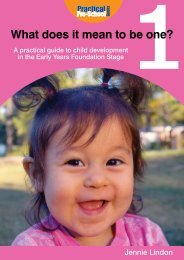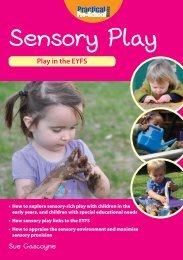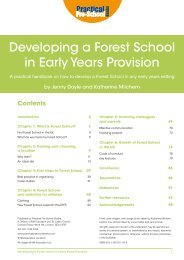Planning for Effective Early Learning - Practical Pre-School Books
Planning for Effective Early Learning - Practical Pre-School Books
Planning for Effective Early Learning - Practical Pre-School Books
Create successful ePaper yourself
Turn your PDF publications into a flip-book with our unique Google optimized e-Paper software.
Leading a thoughtful approach<br />
Example: cutting and drawing<br />
Cutting and making<br />
A chance to draw with biros<br />
In Grove House Infant and Toddler Centre three older toddlers<br />
and twos were enjoying a simple activity of cutting cereal<br />
boxes, occasionally squashing them as well, and adding strips<br />
of paper. They took breaks to chat and look at what the other<br />
children at the table had chosen to do.<br />
The practitioner sitting with the children had planned this<br />
activity from her observations that some children wanted<br />
to cut with scissors but struggled with the skill. She had<br />
gathered the boxes because she knew some of the children<br />
could manage to cut card. She had cut some paper into<br />
strips be<strong>for</strong>ehand, because the children found it difficult to<br />
cut whole sheets of paper. This adjustment enabled some<br />
children to feel a sense of achievement by cutting the strips,<br />
which could also be held taut by an adult. This example<br />
shows attention to appropriate next steps considered by<br />
an adult who knew the children well. She had prepared just<br />
enough to enable these young children to extend their skills.<br />
On a table in the front room some twos were busy with large<br />
pieces of paper. They had crayons and biros but several<br />
children over the morning were most enthused about using<br />
the biros. Young boys and girls focussed carefully, out of<br />
choice, and made a series of deliberate swirly marks, some<br />
of them tight spirals of repeated circling movements. Later<br />
in the day other children were drawing spiders and spidery<br />
shapes. They all held their biro with care and regularly<br />
stopped to look closely at what they had done be<strong>for</strong>e<br />
resuming this meaningful mark making. The children chose<br />
what to draw but adults were ready to admire what they<br />
managed. At one point a practitioner said, ‘Fantastic’ about a<br />
very detailed drawing done by a young boy and he repeated<br />
the word accurately – with a pleased expression on his face.<br />
These very young children were able to select from resources<br />
made available on the basis of adult observations of existing<br />
skills. The children are secure within their learning journey<br />
towards literacy, in terms of making deliberate and meaningful<br />
marks. Appropriate next steps will be more opportunities<br />
like this, as well as the support from the children’s learning<br />
environment which shows writing <strong>for</strong> a reason, along with visual<br />
material. There is good reason to predict that children will be fully<br />
confident in their skills of mark making by the time the abstract<br />
concept of written letters has begun to make sense to them.<br />
42 <strong>Early</strong> Childhood Essentials series: <strong>Planning</strong> <strong>for</strong> <strong>Effective</strong> <strong>Early</strong> <strong>Learning</strong>




